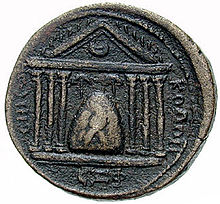
Back حجر مقدس Arabic Бетил Bulgarian Betil Catalan Βαίτυλος Greek Betilo Esperanto Betilo Spanish Betyyli Finnish Bétyle French בית אל (אבן קדושה) HE Baitulos ID

A baetyl (/ˈbiːtɪl/; also betyl), literally "house of God" is a sacred stone (sometimes believed to be a meteorite) that was venerated and thought to house a God or deity.[1] The most famous example is the Omphalos stored in the Temple of Apollo at the Greek town of Delphi.[2]
The term baetyl was used in ancient near eastern sources, in the form of "beth-el", as well as in Greek and Roman sources, as a baitylos. In the former, the term was used to refer to the names of gods or places. Examples include Bethel, a location described in the Hebrew Bible, and the deity Bethel,[3] who was mentioned in texts like Esarhaddon's Treaty with Ba'al of Tyre and the Elephantine papyri. In the latter, the word was used to describe a round stone that had fallen from the sky (i.e. a meteorite).[4]
The word "baetyl" has taken on a vague use in modern writing.[5][6] It has been debated both how ancient and modern usage of this word compare with one another. And, among modern historians, concerns have risen over the precision, accuracy, and generalizing tendency of the usage of this term in describing ancient texts and material objects.[7][8] The term has been used expansively, referring to any cultic stone regardless of the type or shape of stone that it was, such as whether it was a rounded stone (or ovoid), a pillar, or a stele (standing stone).[9][10] This generalization has been criticized as not corresponding to ancient use of the term itself and resulting in a projection of the modern sense of the word (a sacred stone containing the presence of a deity) onto a wide variety of cultic stone objects where little evidence exists for such an understanding existed, as in the case of the Nabataeans.[11]
- ^ "Baetyl". Livius. Retrieved 2024-05-16.
- ^ Doniger 2000, p. 106.
- ^ Hyatt 1939.
- ^ Gaifman 2008, p. 44–46.
- ^ Pagolu 1998.
- ^ Marinatos 2010, p. 87.
- ^ Gaifman 2008, p. 42–44.
- ^ Wenning 2001, p. 80.
- ^ Falsone 1993.
- ^ Doak 2015, p. 79.
- ^ Gaifman 2008, p. 57–67.
© MMXXIII Rich X Search. We shall prevail. All rights reserved. Rich X Search